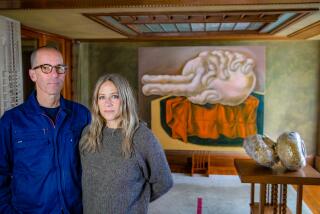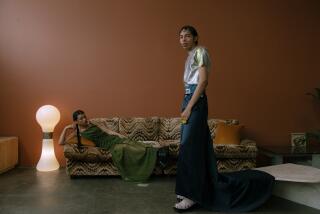Office Geometry
- Share via
Just as DNA is the building block of life, the dna line of modular components designed by Richard Holbrook can provide the building blocks of a small office. Holbrook’s own space, in the second story of a renovated 1926 former bank building in Old Town Pasadena, is a showcase example. A comfortable blend of refinished oak flooring and exposed brickwork offsets the high-tech furnishings made from hard polycarbonate and brushed metal alloy.
As would be expected, most of Holbrook’s workspace is made up of his firm’s components; his desk is a simple white tabletop with nicely rounded edges seated on four brushed-metal legs atop rollers. To the side and behind are two wall-mounted units--storage cubicles and drawer units interspersed with shelves and work surfaces, mounted on vertical rails.
Holbrook, 43, created dna to respond to the ever-evolving requirements of small businesses. “The system’s meant to be highly flexible,” he says. “You can put these things together to suit your needs.” And, he adds, it’s also designed to be durable and affordable--a typical workstation, with wall unit and table, costs from $750 to $1,400.
In the showroom on street level, Holbrook shows how dna units are assembled. The standard storage cubicle is 14-by-14 inches and the shelves 14 inches across, and the individual components can be aligned or offset to create a zigzag effect. Each shipment comes with a yardstick, a level and a paper tape guide that indicates the space required between the vertical support rails. The rails are mounted to the wall, then work surface and cabinets can be attached through a pin-lock system. To demonstrate the weight-bearing strength of a wall-mounted cubicle, Holbrook grasps onto one and executes a couple of chin-ups. “I don’t recommend others doing this though,” he quips.
A workstation can also be free-standing or, for maximum mobility, mounted on wheels. Movable screens are available to divide workstations, and dna also has a line of accessories such as pencil cups, coat hooks and CD clips that can be attached to a track. Ergonomic chairs are also part of the dna line, either plain with ventilated backs or minimally upholstered. With time, more items will be added to the system.
Holbrook has kept his color palette simple and modern--brushed silver alloy rails and cabinet shells, with white, gray, black and orange for cabinet fronts and work surfaces. “I wanted to keep it all very simple, and let people’s own things decorate the environment,” he says. His own workspace displays memorabilia and snapshots of his family on the shelves.
As a teenager, Holbrook had an inclination for drawing and for cars, but growing up in a working-class family in La Mirada, it never occurred to him to go to college. A high-school teacher recognized his talent and suggested a Saturday class at the Art Center College of Design in Pasadena. “It was the most tremendous revelation,” Holbrook says. “It dawned on me that I might actually make a living designing cars, drawing cars, which I loved to do.”
He applied for full matriculation to the Art Center, was accepted and, through a scholarship and part-time work, made his way through four years. Upon graduation in 1981, he was offered a dream job--to work on car design for Peugeot in Europe.
Holbrook spent his first two years at Peugeot in Coventry, England, then transferred to Paris for another two years, eventually becoming a design chief. He worked on every aspect of the design for a low-slung, angular sedan--from the nose to the tailpipe. But the car was never put into mass production. A competing design by Sergio Pininfarina, the Italian responsible for the look of many Ferraris and Alfa Romeos, won out, says Holbrook, “because he had the name appeal.”
The experience soured Holbrook on corporate life. “I couldn’t face the idea that I could work there the rest of my career and never have anything on the road,” he says. “And then the whole corporate thing--the bureaucracy, the politics, all that stuff. I realized I’m a entrepreneur at heart. I love taking risks and reaping the rewards of those risks.”
In 1985, Holbrook returned to California, taught commercial design at his alma mater and started up his first design company. Over the years he has designed kitchen appliances for Dacor and Thermidor, ceiling fans for Casablanca Fan Co., and furniture for Herman Miller. Among his best-known work for the latter are the highly adjustable Ambi chair, which sells for $500 to $800 depending on the features, and the Levity workstation, which Holbrook has in a corner of his dna office. He shows how the Levity’s desk surface can be height-adjusted with ease, even when fully laden. In 1998, the Levity system won the Gold Award for Innovation at the NeoCon design conference, but it was so expensive to produce that sales lagged--and it was eventually discontinued.
That’s when Holbrook decided to create more affordable office furniture, focusing on small business and the home office. He asked himself, “How can I use the Internet along with some inventive product design to help solve the needs of people in small to medium business at a price and delivery time that would be acceptable?”
Last year, he and business partner Michael Shannon signed an agreement with Teknion, a well-known office furniture company based in Toronto, to create the dna company. The line is currently sold through Teknion dealers throughout the United States, as well as online at www.tekniondna.com. They can be seen at Workplace Interiors in Culver City, Jules Seltzer Associates on Beverly Boulevard, or dna headquarters at 24 N. Marengo Ave., Pasadena.
Being involved in all aspects of his fledgling company is his passion, from the creation of the products to the marketing strategy. “I’m designing a company, that’s the fun for me,” he says. “It’s hard to find companies that have a true integrity of design and vision running all the way through--my dream was to get enough independence to create a brand.”
More to Read
Inside the business of entertainment
The Wide Shot brings you news, analysis and insights on everything from streaming wars to production — and what it all means for the future.
You may occasionally receive promotional content from the Los Angeles Times.









